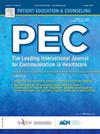信息和不确定性:利用儿科肿瘤学功能沟通模型更好地了解早期AYA生存和晚期影响沟通。
IF 3.1
2区 医学
Q2 PUBLIC, ENVIRONMENTAL & OCCUPATIONAL HEALTH
引用次数: 0
摘要
目的探讨青少年癌症患者在讨论生存和晚期效应(LE)方面的沟通偏好,并确定LE沟通的关键沟通功能和需要改进的领域。方法采用青少年肿瘤学功能沟通模型对17名12-22岁青少年进行半结构化访谈,分析青少年肿瘤学功能沟通偏好。有目的的抽样确定了正在接受癌症治疗或在过去五年内完成儿科癌症治疗的参与者。采访发生在2022年4月至2023年4月之间;它们被录音、转录并单独编码。专题分析确定了在传播职能中出现的主题。结果参与者认为“交换信息”和“管理不确定性”是幸存者沟通的关键功能,但强调了需要改进的领域。许多青少年很早就接受了信息,但是内容的数量是压倒性的,有些人尽管获得了信息,但仍对生存感到措手不及。青少年强调心理健康支持和同伴认可的重要性,指出心理社会资源方面存在差距,并希望与其他幸存者分享更多经验。影响青少年如何接受晚期效应信息的沟通偏好的修饰因素包括治疗阶段(积极治疗vs生存)、个人学习偏好、现有的亲子动态和诊断/预后。结论利用沟通功能作为一个框架,使我们能够更好地了解青少年的偏好,并确定在早期沟通中关于生存和LEs的改进领域。了解影响青少年偏好的修正因素将有助于定制沟通策略以更好地满足他们的需求。实践意义本研究应用了一个经过验证的框架来与儿童肿瘤学的弱势患者群体青少年进行生存和晚期影响沟通,突出了需要改进的重要领域。研究结果可用于指导未来针对青少年的干预措施,旨在提高青少年对生存护理和基于风险的筛查的参与度。本文章由计算机程序翻译,如有差异,请以英文原文为准。
Information and uncertainty: Utilizing the pediatric oncology functional communication model to better understand early AYA survivorship and late effects communication.
Objectives
To explore the communication preferences of adolescents with cancer regarding the discussion of survivorship and late effects (LE) and to identify key communication functions and areas for improvement in LE communication.
Methods
This qualitative secondary analysis applied the adolescent oncology functional communication model to 17 semi-structured interviews conducted with adolescents (aged 12–22 years) to understand their LE communication preferences. Purposive sampling identified participants undergoing cancer treatment or who had completed pediatric cancer treatment within the past five years. Interviews occurred between April 2022 and April 2023; they were audio-recorded, transcribed, and individually coded. Thematic analysis identified themes that emerged within the communication functions.
Results
Participants identified "exchanging information" and "managing uncertainty" as critical functions in survivorship communication, but highlighted areas for improvement. Many adolescents appreciated receiving information early, however the volume of content was overwhelming, and some felt unprepared for survivorship despite information. Adolescents emphasized the importance of mental health support and peer validation, pointing to gaps in psychosocial resources and the desire for more shared experiences with fellow survivors. Modifiers to communication preferences which influenced how adolescents wanted to receive information about late effects included the phase of treatment (active treatment vs. survivorship), individual learning preferences, existing parent-child dynamics, and diagnosis/prognosis.
Conclusions
Utilizing communication functions as a framework allowed us to better understand adolescent preferences and identify areas for improvement within early communication about survivorship and LEs. Understanding the modifying factors that influence adolescent preferences will help tailor communication strategies to better meet their needs.
Practice Implications
This study applied a validated framework to survivorship and late effects communication with adolescents, a vulnerable patient population in pediatric oncology, highlighting important areas for improvement. The findings can be utilized to guide future adolescent- specific interventions aimed at improving adolescent engagement in survivorship care and risk-based screening.
求助全文
通过发布文献求助,成功后即可免费获取论文全文。
去求助
来源期刊

Patient Education and Counseling
医学-公共卫生、环境卫生与职业卫生
CiteScore
5.60
自引率
11.40%
发文量
384
审稿时长
46 days
期刊介绍:
Patient Education and Counseling is an interdisciplinary, international journal for patient education and health promotion researchers, managers and clinicians. The journal seeks to explore and elucidate the educational, counseling and communication models in health care. Its aim is to provide a forum for fundamental as well as applied research, and to promote the study of organizational issues involved with the delivery of patient education, counseling, health promotion services and training models in improving communication between providers and patients.
 求助内容:
求助内容: 应助结果提醒方式:
应助结果提醒方式:


